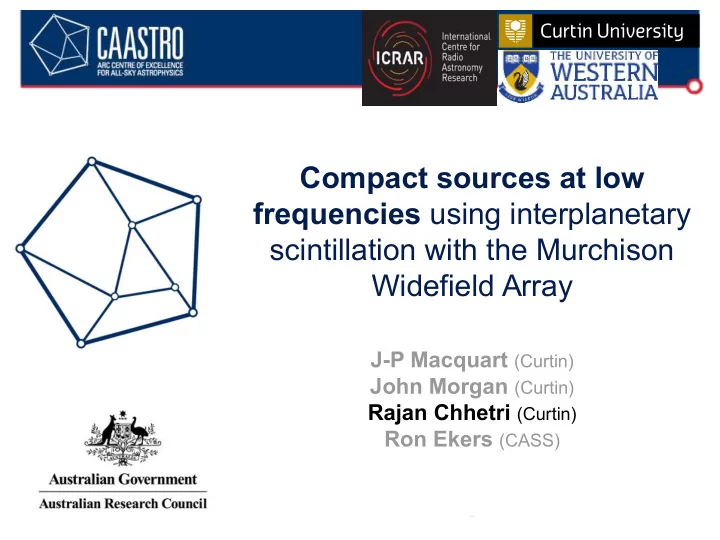

Compact sources at low frequencies using interplanetary scintillation with the Murchison Widefield Array J-P Macquart (Curtin) John Morgan (Curtin) Rajan Chhetri (Curtin) Ron Ekers (CASS) John
Surveys and Angular Resolutions Credit: Heald et al. 2015
Surveys and Angular Resolutions Credit: Heald et al. 2015
The Instrument › The Murchison Widefield Array (Western Australia) › 128 tiles with 2 x 16 dipoles each › Operating frequencies: 80 – 300 MHz › Bandwidth: 30.72 MHz Credit: N. Hurley-Walker Credit: NRAO/AUI (modified)
The Enabling Instrument › The Murchison Widefield Array (Western Australia) › 128 tiles with 2 x 16 dipoles each › Operating frequencies: 80 – 300 MHz › Bandwidth: 30.72 MHz › Field of View: 15 – 50 degrees (200 – 2500 sq degrees) › Temporal resolution: 0.5 sec › Excellent instantaneous UV coverage Credit: N. Hurley-Walker Credit: NRAO/AUI (modified)
Typical MWA field Angular resolution ~ 2'
MWA field in TGSS Angular resolution ~ 25''
Current Low Frequency Instruments' challenge › Field of View: 15 – 50 degrees (200 – 2500 sq degrees) › Very large number of sources in the field of view › Angular resolution (3-km array) at 150 MHz > 2 arcmin Image credit: N. Hurley-Walker
The Low Frequency solution? › Field of View: 15 – 50 degrees (200 – 2500 sq degrees) › Very large number of sources in the field of view › Angular resolution (3-km array) at 150 MHz > 2 arcmin VLBI Image credit: EXPRes website
The Low Frequency solution? › Field of View: 15 – 50 degrees (200 – 2500 sq degrees) › Very large number of sources in the field of view › Angular resolution (3-km array) at 150 MHz > 2 arcmin VLBI › Time consuming › Very high number of sources Not a practical solution Image credit: EXPRes website
Interplanetary Scintillation Compact radio sources (< 1 arcsec) + Turbulence in interplanetary plasma = Scintillation effects (random fluctuations in flux density) Credit: Readhead+1978
Interplanetary Scintillation Compact radio sources (< 1 arcsec) + Turbulence in interplanetary plasma = Scintillation effects (random fluctuations in flux density) Analogous to the effects of twinkling of stars in optical wavelengths Credit: Readhead+1978
Interplanetary Scintillation Field started by: M. Clarke Hewish, Scott & Wills Nature 1964 Survey of the Northern sky by Purvis et al. 1987 Dedicated instruments e.g. STELab (Japan)
Background on IPS with MWA • Pilot study by J. Morgan, Curtin University • Regular daytime observations (late December 2015 – July 2016) • Observations at two bands 80 MHz & 160 MHz • Over 4000 observations made of different parts of sky • Highest (0.5 second) temporal resolution of the MWA correlator
IPS strategy with MWA Simulated MWA beam at 150 MHz Credit: Tingay et al. 2012
How do we do it? Data processing • Image data as a continuum image • Image at 0.5 second integration in both frequency bands and polarisations • Produce variance image across ~ 600 images • Run source finding script – Aegean (Hancock et al. 2012)
Variance Imaging Data processing • Image data as a continuum image • Image at 0.5 second integration in both frequency bands and polarisations • Produce variance image across ~ 600 images • Run source finding script – Aegean (Hancock et al. 2012) • Identify sub arcsecond compact components in large number of MWA sources simultaneously
Typical MWA field
Typical MWA field Field size: 23 x 8 sq degrees
Using Variance Imaging Field size: 23 x 8 sq degrees
Scintillating Source
Non Scintillating Source
Some Results
Some Results
Some Results
Some Results
Detect Numerous Peaked-Spectrum Sources SEDs Credit: Joe Callingham
Higher moment images
Surveys and Angular Resolutions Credit: Heald et al. 2015
Surveys and Angular Resolutions Credit: Heald et al. 2015
Summary • Extremely efficient identification of compact sources at arcsecond scales at low radio frequencies from wide-field images. • Estimates of active cores: a very small fraction (~5%) as opposed to >80% at high radio frequency (20 GHz). • Angular size estimates for peaked sources that are readily identified. • Excellent complement to GLEAM and TGSS.
Thank you
Some Results IPS affected by ionospheric effects? Dec RA
The visibility-spectra plot
Recommend
More recommend